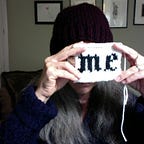Writing: My personal drama
Over the past twenty years of my academic career I have embarked upon unrealized long-term research and writing projects once, twice, three, four times. Despite three-plus strikes, I have decided that I am not yet out.
The first project died when the group project leader, after valiant efforts, couldn’t find a publisher.
The second one died when the interminable front-end work gave way to the announcement of a final due date. I was not ready.
The third one died when I agreed to chair an art department comprised of 30 full-time faculty, 30-plus contingent faculty, 160 or so courses, nine programs, 600 undergraduate and graduate students, and three lowest-bidder-constructed buildings full of chemicals, gases and dangerous equipment. I taught a class each semester and raised a growing child at home.
I am resurrecting the fourth project, I promise. The third one, too.
This is what I do: I research my ass off and create lengthy annotated bibliographies and lit reviews. I interview people. I conduct surveys. I write and rewrite and polish the preface, introduction, and first chapter. And then I get stuck. Time goes by and I put another sealed box of laser-inked paper into the basement.
As I meet every other week with the accomplished and sharp-witted women (and, likewise, Johnathan Strube who coordinates us) in my Design Incubation writing group I struggle to understand why my track record as a writer in academia is so barely existent.
Out of college I wrote, intermittently and reasonably well, articles about fashion and design for the alternative press (Chicago’s Windy City Times, Minneapolis’ City Pages) and dry little books about health, the environment, and cannabis for middle-schoolers (Chelsea House Publishers). That nanoscopic pay was what I lived on.
But in academia the stakes are higher and different. How does one learn how to do this work especially without the edifying experiencing of earning a PhD?
One colleague learned to be a scholar by very carefully observing and mimicing the research and production activities of their domestic partner, a more established academic. This worked very well. Another colleague learned from their mother, whom they followed into academia.
I learned from the institutions I was part of.
Historically, the culture of the art department privileges solo genius and the dissemination of work in credentialed institutions. Though as a Chair evaluating faculty work for I often built a case for collaborative scholarship and projects that were disseminated in new digital venues, for myself I internalized the outdated ideal of single-handed scholarship.
When I was tenured my client-based work was accepted as part of my design scholarship. In these projects the scope of work, timeframes, and desired outcomes were all externally generated.
That I spent years working within structures created by others rather than creating my own is embarrassing to acknowledge.
Now as a mid-to-late career academic, I am in a period of relearning. My kid is in college. I’ve returned to teaching undergraduate designers. Considering what I want them to know, I also discover what I need to learn.
There are many venues for our work.
Deadlines can be renegotiated.
Carve out time for what’s personally important.
Create/join a community.
Establish your own values and standards for your work.
Honor your interests.
Your voice will out.
